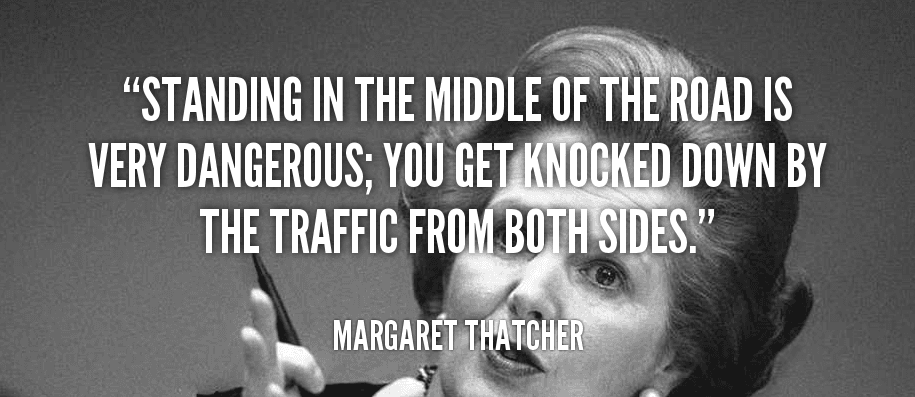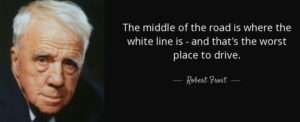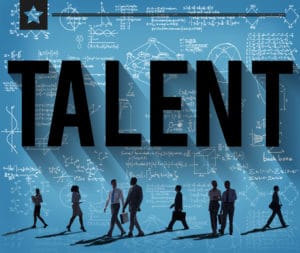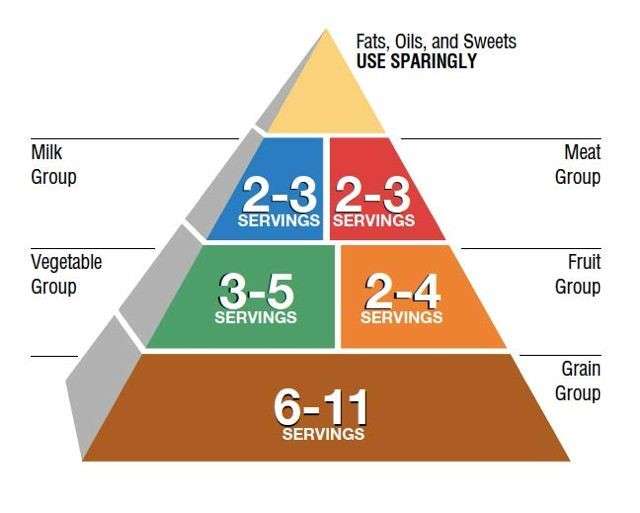
by Adam L Stanley | May 4, 2017 | Leadership, Quotes and Inspiration, Relationships, Teamwork
Be in it to win it or leave the race.
Nothing good comes from being in the middle of the road. It’s funny we often take for granted little things that have overarching meanings in our everyday life. Take driving. Learning the rules of the road and using them keeps us and others safe while sending a clear message about the direction we’re traveling. What happens when we forget these rules? Ever seen the person flying onto an on ramp and merging into traffic without signaling? Or the person who wants to straddle the line on a thin dual-direction road? On the road and in life one thing is clear: you cannot both be coming and going at the same time. We can do either but the rules of the road force us to make a choice.
And in our career, what happens when we refuse to choose? Many believe we can straddle the professional line without anyone noticing. With one foot in our current role and the other waiting for the next best thing, we remain unaware that our ambivalence reeks.
It is important that we pick a side.
PICK A STRUGGLE
Adam wrote a blog a while back that was titled Don’t Miss your Bernie moment. The message was in general for leaders of organizations that have gone through major periods of change. The Bernie message was one of transition. It was saying to his supporters that the time has come to move on, united against a common evil, and rally together on a new shared mission. That blog was for leaders at the top of newly merged or fundamentally changed organizations. And it should absolutely resonate for many of you out there.
But there is another message and this is for everyone in the organization under such leaders. And the message is basically that once a leader has articulated the new shared vision for the organization you have a decision to make. Either align with that leader and support the mission, helping to drive the continued success of the organization. Or decide that this mission is simply not yours and move on. You need to pick a struggle. You need to pick a side. Just like being in the middle of the road while driving is not a viable option, being in the middle of the road as a member of a team is unacceptable.

Let’s be clear here. We are not at all saying that adherence to the mission of an organization requires a level of abject acceptance of any decisions that are made and any directions that are delivered. The value you bring to an organization is of course diversity of opinions and the ability to provide input into decisions driving the future of your organization. Never change that. However, there is a base level of acceptance that is required of any player on a major team.
Adam is a very big fan of Arsenal Football Club and anyone who knows the English Premier League teams knows that to some extent each team is fundamentally different than other teams. Their leaders are different and their style of play are also different. If someone joins Arsenal, the expectation is they will bring new talent, new ideas, and new strength to the club. However, they will still play under the style and direction that has been developed over dozens of years. They cannot come in and try to be a rock superstar constantly fighting against the leadership or their fellow team members. It simply does not work.
So, you’re at a Crossroads. You joined the company and you worked for a particular leader for years. You respected that leader and admired his or her vision for the future of the company. You now have been placed under a new leader and you dislike your new mission.
It is time to decide.
Our advice for you:
1) Consider what makes you happy at work. Be very honest and open with yourself. Be sure that you are not letting personal friendships or biases get in the way of sound judgment. I have worked for people who are fantastic people that I truly respected and I liked. But they were not always aligned with me strategically or going in the direction that I actually thought was best for our company.
2) Ask lots of questions and truly get to know the new leader. If you suspect there is a fundamental misalignment with your view of strategic direction for the company, do your research. List out your perceived differences and ask questions that get to a point where you can confirm one way or the other. You may actually be surprised both at your misunderstanding of the misalignment or in your leader’s interest and ability to change based on strong feedback
3) Check the grass on the other side. Research other players in your industry and see if they are going in a fundamentally different direction. It could be that your ideas are not aligned with the way the world is shifting. You could be the one on the wrong side of the road. And hey, we’ve all been wrong sometimes. This exploration of the other side will also help you and your decision to stay or leave for another company. If, after all, other companies in your industry will be going in the same direction, you might be left all alone.
 4) Change your way of thinking. Adam wrote a blog on Allies on a Tour of Duty, about investing in talent for the long-term. The concept there was around each role being a different opportunity for you to build on particular skills and learn new ones. Never considering that any would be permanent. Change your way of thinking so that this new strategic direction under this new leader is another Tour of Duty. It’s an opportunity for you to prove that your intellect and your skills are transferable and can be applied under different fields of battle.
4) Change your way of thinking. Adam wrote a blog on Allies on a Tour of Duty, about investing in talent for the long-term. The concept there was around each role being a different opportunity for you to build on particular skills and learn new ones. Never considering that any would be permanent. Change your way of thinking so that this new strategic direction under this new leader is another Tour of Duty. It’s an opportunity for you to prove that your intellect and your skills are transferable and can be applied under different fields of battle.
5) Determine your time horizon. There is a particular amount of time that you will wait it out and try to make it work before one of two things happens. Either you will become so despondent and disengaged that you will be miserable at work and miserable to work with. Or, your performance will suffer and your contributions will decline and instead of leaving on a high you will leave with an impression a failure. When not happy at work, your performance will suffer and your reputation can as well.
6) Just Leave. If you’ve come to the conclusion that it’s simply not going to work or you don’t want it to then you should do yourself and the organization a favor and respectfully exit. Fortunately, we are not tied to any one company and where we decide to work is a choice. Choose to be solid teammate and manager, productive and most of all happy…elsewhere.
Choose Your Side
Staying in the middle of the road is not good for any players involved. Your leadership will be disappointed in your performance and your attitude. Your peers will notice your lack of Engagement. And those that do not know you well will brand that as part of your personality and your skill set. And you will be unhappy and feel increasingly disengaged and alone. That is a position that no one wants to be in at work. Therefore, we encourage you to pick a struggle. Pick a side.
Let us know what you think. Have you been in a situation where your colleague was clearly straddling the middle line? Have you managed someone like that?
Be well. Lead On.
Adam
This blog was coauthored with Apriel Biggs-Coker. These are our views and not necessarily those of the company.

Adam L. Stanley Connections Blog
Technology. Leadership. Food. Life.
AdamLStanley.com
Follow me on Twitter | Connect with me on Linked In | “Like” me on Facebook

by Adam L Stanley | Jan 24, 2017 | Leadership, Teamwork
I’ve fallen and I can’t get up
Many of my American readers will have seen the commercial with an older woman who has fallen in the bathroom and needs help. “I’ve fallen, and I can’t get up,” she calls out. Luckily, she has Life Alert, a device that allows customers to, in the event of an emergency, simply press a button on a small pendant and call for help. The commercial’s premise is that because this woman had thought about her weaknesses BEFORE she had the fall, she was able to be rescued and live to tell her story.
When do most businesses try to change, or shift something up? (A new revenue stream, new reporting structures, reduction in headcount, etc.) Usually — not always, but definitely the majority of the time — change management efforts come when the company is doing poorly. When things have fallen and they can’t get up! This is logical. Usually change is a reaction to less-than-expected performance, or the belief that the company needs to be shaken up to get back on track.
I came across this thought from Trevor Edwards, the President of NIKE Brand, recently. It speaks to the same idea:
“Most change is driven by poor performance, but rather than waiting for a crisis — consider disrupting the status quo when the numbers are strong. Trying to revamp your business in a crisis can lead to bad decisions. Your thought process will be clearer when things are going well.”
I couldn’t agree more. I also think it applies to both personal and professional life.
Making changes in your personal life
Personally, a lot of people try to make changes when they feel they are at rock bottom. They’ve lost a job, a relationship has ended, a family member or friend dies suddenly, and emotions send them grasping for change. But when you make a change at that point, you’re entirely reacting to the most recent negative event. If you got fired for a specific performance issue, you may over-focus on correcting that performance issue as you look for new jobs. But you may have been great at that aspect of a job; the evaluation may have been subjective, or you may have really been terminated to help the company meet a growth target. Likewise, running away from a job, or any other relationship, because things are bad can lead to a disastrous “boomerang” effect. You may hate the new [fill in the blank] more than the former.
Negativity reduces context. That’s a good reason to consider personal improvements when you’re already feeling good about life. It will give you more perspective.
Applying this to companies
 On the professional front, I use the term “tour of duty” a lot. It’s a different way of thinking about the standard employment contract. Basically, you are bringing people in for specific jobs. They do those jobs and they either roll off or they transition onto another team/project. Josh Bersin, a people development thought leader, calls this a “team of teams” approach. You see it commonly in the military and in the consulting industry, and it’s becoming more commonplace elsewhere.
On the professional front, I use the term “tour of duty” a lot. It’s a different way of thinking about the standard employment contract. Basically, you are bringing people in for specific jobs. They do those jobs and they either roll off or they transition onto another team/project. Josh Bersin, a people development thought leader, calls this a “team of teams” approach. You see it commonly in the military and in the consulting industry, and it’s becoming more commonplace elsewhere.
It makes sense because oftentimes, job roles are very unclear. They’re clear at first — the hiring was a response to an immediate need of a hiring manager — but after that need becomes less of a priority, the person hired is still on the books. Sometimes, they can become a 8-to-10-year employee and not have a clear role for much of that time. This limits flexibility of the organization. You can’t do strategic pivots, and you can’t do effective change management, if you have a lot of people locked into intractable, potentially unnecessary roles.
The elephant in the room here is terminations. When we talk about companies changing in the bad times instead of the good times, usually the main way that happens is terminations. These happen for a variety of reasons: companies trying to clear money to prove growth, trying to deal with a performance issue that’s been lingering, or a host of other financial reasons.
Regardless of why the company is embarking on terminations, it’s almost always a bad play. Research has shown layoffs don’t have short or long-term benefits. They’re simply just a reaction to a bad revenue cycle.
If you consider the approach of “change while times are good” and you structure your hiring more as “tour of duty,” I think a lot of these issues can be alleviated. Sadly, the nature of most companies these days isn’t to reward employee longevity. So from an employee side, loyalty has been declining for years as people think they may be better off thinking as independent contractors moving from one project to the next.
Consider the example of Jason Fried, the CEO of Basecamp. They were doing super well in 2014, onboarding 100s of new clients every day. He still decided to radically shift the company and its reporting structures, saying at the time:
“Change is great – as long as it’s not forced change. Forced change is often resented change. When you’re forced to change because things aren’t going well, you’re often rushed and unhappy. When you decide to change when things are going great, you can do it on your own schedule and your own way. That’s what we decided to do – we decided to make this change right now while business has never been better.”
Amen, sir.
 Top 3 reasons to change while times are good
Top 3 reasons to change while times are good
Busy executives, especially those who are driving innovation in the digital economy, will continue to struggle with organizational change in the midst of transformation change. BUt the fact is, they are completely interdependent. You cannot lead a major business transformation without a people transformation and vice versa. So, constantly looking at your organization and looking for ways to restructure, rethink, reduce, and redeploy will make you more successful.
In short, there are three major benefits to changing while times are good:
- Priority of focus: The changes occur on your time/schedule, as opposed to a rushed process to meet certain accounting goals.
- Sensitive to employees: Changing in boom periods allows for thoughtful change that’s ultimately considerate of individual impact.
- Smarter: When you change in a good cycle, the decisions will be better and rooted in a clearer thought process.
I know this isn’t always possible, and sometimes in the good periods you just want to ride the train of revenue growth and not think about what can be changed, but I hope the above is a compelling context for why your best quarters are exactly the time to shake things up.
Be well. Lead On.
Adam

Adam L. Stanley Connections Blog
Technology. Leadership. Food. Life.
AdamLStanley.com
Follow me on Twitter | Connect with me on Linked In |
Related Posts:
Disruption: Thinking like our ancestors
Innovations that are Changing our Industry
Disrupters learn from the losers
Riding a wave of change
Yet another blog about Change!
by Adam L Stanley | Dec 8, 2016 | Life, Technology
Make your Uber driver feel good. He may not be making much money. And you’re really not “sharing” anything with him.
The ALS 5-Star Uber Service
Recently, I decided to do a little experiment.
Several people in my circles talk regularly about the sharing economy. I have read dozens and dozens of blogs on the model — and actually work with accelerators and incubators that are also very much focused on the topic.
Here’s the issue I’ve always seen, though: many of us experience the sharing economy as users, not as providers. If we’re not exposed to both sides of it, it’s hard to really understand what’s going on and how it’s going to impact business and growth (and yes, politics and society too) in the next decade and beyond. Most of my friends have stayed in an AirBNB, for example — but only 1 or 2 have rented their place out. Almost all my friends and colleagues have used an Uber, but none have driven one.
So, I decided to sign up. I wanted to see what it was like to be an Uber driver.
Signing up

The first step — signing up — is surprisingly easy. The process involves a background check which is done by a third party and the collection of several documents that verify that you are legally licensed to drive that vehicle. The process for me took approximately one week including the time to go to a local Jiffy Lube for relatively simple car inspection. Because of the vehicle I drive, I was also able to request the ability to drive as an Uber Select driver, which merits higher rates per mile and a different clientele. (You’ve probably ordered a Select once or twice.)
This was getting real now — I was signed up — and once stuff gets real for me project-wise, I go whole hog. The next step was preparing the car. I bought some mints and candies for the armrest, and I put magazines in the back that passengers could read. I set up in-vehicle Wi-Fi and provided chargers for Android and iPhone devices. I made a brochure about everything I was doing and stuck it in the back. I was aiming for five-star service every time out.
I got my mounting device for the dashboard, installed Waze, and started taking rides. I was now on the other side of the sharing economy. I had crossed the chasm.
So, what did I learn?
Basic economics
 About half my rides were Uber Select; the other half were UberX (the most common). A large percentage of my UberX fares were surge, i.e. 1.1-2x the traditional fare via demand, but most Select were base fares.
About half my rides were Uber Select; the other half were UberX (the most common). A large percentage of my UberX fares were surge, i.e. 1.1-2x the traditional fare via demand, but most Select were base fares.
It’s hard to make money. In one trip, I drove a passenger through traffic for 21 minutes and my take home was about $4 adjusted for income taxes. I cannot for the life of me figure out why someone would be a part-time UberX driver. I get the flexibility element — also heard of an Uber driver who has six kids once, and I get maybe using Uber as peace and quiet — but it’s not a true revenue generator in any real sense. My question is whether or not the average driver tracks mileage to and from pickups, uses the tax code to his full advantage to deduct expenses, and has a car where the cost of depreciation is lower than the benefits of Uber fares.

Uber has recently decided to allow drivers to accept tips in certain markets. As a reaction to lawsuits, the stipulation allows tips as long as they use as a separate transaction or via cash.
People are condescending
A lot of times, they don’t even realize it. You might be in this boat without realizing it. I constantly got questions about why I do Uber and/or how else I really make money. There were also dozens of comments implying “Oh, you’re smart for an uber driver” or act shocked that I was “a better conversationalist than I expect from an uber driver.” It was really amazing to see this in real-time, ride after ride.
Drunk people are awful
Some people really never do grow up after high school or college. When drunk people spilled into my car, it’s all crass and racism and ridiculous, no-context comments. No one puked in my car (I’ve seen stories about that from Uber drivers), but verbally, almost all the drunk people puked everywhere. Obnoxious at 20. Ridiculous at 40.
Uber has begun piloting means of protecting drivers from drunk passengers, or at least minimizing impact of the distraction. Drivers get a $200 cleaning fee when someone throws up in your car and several expert drivers have posted blogs with tips on avoiding the worst offenders and managing the other drunk passengers. The dilemma for Uber is that it touts its services as a drunk-driving solution to generate political juice. This is Uber’s pitch to Upstate New York. If too many of Uber’s part-time drivers begin refusing to service drunken passengers, this claim will lose effectiveness.(see article)
Spilling the Beans
Absolutely shocking how many secrets were revealed in conversations between passengers, including — not even kidding here — people working as consultants or investment bankers on confidential matters. I started thinking: if someone drives an Uber at a major U.S. airport and it takes about 30 minutes to get downtown in whatever city, how easy would it be for Uber drivers to basically do real insider trading off what they hear? Or simply to ruin a deal by tweeting or posting it on Facebook.
The ratings game
 I nailed my five-star rating. During my 19 trips, 15 passengers gave me ratings and all of them scored me a 5. I believe Uber now requires ratings on every fare. When I did my experiment, this was not the case. After every fare, I would find myself anxiously awaiting my rating. I wonder whether my perfect score would be different had Uber required ratings when I drove. Perhaps the people who did not rate me were not as impressed with the quality of my service and would have rated me lower.
I nailed my five-star rating. During my 19 trips, 15 passengers gave me ratings and all of them scored me a 5. I believe Uber now requires ratings on every fare. When I did my experiment, this was not the case. After every fare, I would find myself anxiously awaiting my rating. I wonder whether my perfect score would be different had Uber required ratings when I drove. Perhaps the people who did not rate me were not as impressed with the quality of my service and would have rated me lower.
After about 20 fares, it does become increasingly easier to maintain that high rating. In the first 20 fares, it’s a little bit more a situation where every fare (and subsequent rating) makes a huge difference. As a passenger, I had just ok rides with 4.9 rated drivers that had taken hundreds of fares. But I also had amazing rides with newer drivers with 4.5 that had only 10-20 fares. One or two passengers in a bad mood can ruin a starting driver. New drivers are given some slack on their rating, but a rating below 4.6 puts you at risk of being deactivated.
Getting Lost
I don’t know Chicago as well as I thought. Certain neighborhoods were a total mystery to me — even sometimes 6-7 minutes from places I do business all the time. If I had turned off Waze, I’d be totally lost. That was surprising to me. This is a major differentiator for taxis. If you want to get good ratings, you need to really get to learn the streets of the city in which you live.
No Dates or Mates
It’s not really a networking tool. I heard people classify Uber as a networking tool often, but that’s not really true. I ultimately did 19 rides. No one hit on me — although maybe that’s my issue. No one encouraged me to hit on them. And I didn’t start any business partnerships or friendships, no. I thought about the term “sharing” within sharing economy a lot when I was doing this. Most of the passengers are basically paying less — and getting it faster — than they would with a traditional taxi. They’re not sharing anything. It’s an economic exchange at the micro level. (more on that here)

To Uber or not to Uber
I wouldn’t recommend Uber to people looking to make extra cash. I don’t actually feel the economics are there. There are a couple of situations where it could be advantageous, though. For example:
● If you have a nice leased car and you don’t drive more than the allowable mileage on a regular basis, it makes some sense.
● If you’re interested in human psychology or think it could benefit you professionally to understand people a little bit better — and you have the time — then it’s valuable.
● If you’re a person who would otherwise be sitting home downing Doritos and not interacting with other human beings, do it.
● Short-term need for cash for a trip? Definitely consider it.
● You’re just a curious person.
If you are going to drive, here are a few blogs with independant tips on optimizing your experience:
Now look: I did 19 rides. It’s not a huge sample size and I don’t portend to be any expert on being an Uber driver as a result. One Uber driver claims he is raking in $252,000 a year, largely by selling jewelry to his passengers as he drives. But to understand the sharing economy, you need to check out both sides of it. There are people legitimately making money and connections from being a driver, but there are pros and cons like ANY means of generating income. Also, it seems Uber’s long-term plan could be to phase out drivers — you’ve got their purchase of self-driving Otto trucks, and you’ve got their billionaire CEO alluding to it left and right. It’ll be interesting to see what happens when the sharing economy starts to get automated out as well.
For now, though, I would love to hear your perspective on the sharing economy. And if you get a chance, hit on your next Uber or Lyft driver. Might make ‘em feel better… Just saying.
Be well. Lead On.
Adam
Here is the full log of trips:

Related Posts:
Applying the food pyramid to tech talk
Disrupters learn from the losers
Peer accountability is critical to success in teams

Adam L. Stanley Connections Blog
Technology. Leadership. Food. Life.
AdamLStanley.com
Follow me on Twitter | Connect with me on Linked In | “Like me on Facebook

by Adam L Stanley | Oct 24, 2016 | Leadership, Technology
Technology leaders must think like Disruptors
A decade ago, the five most valuable companies on the S&P 500 were Exxon, GE, Microsoft, Gazprom, and Citigroup. Now? It’s Apple, Alphabet (Google), Amazon, Microsoft, and Facebook. Things change. And they change fast. And many technology leaders are not ready for it. In some ways, none of us are.
Amazon is maybe the ultimate disruptive company; it essentially ushered along a completely new way of thinking about commerce. But interestingly, before Amazon started there was another disrupter called Webvan. In 1999, myself and a group of fellow Wharton MBA students in an e-commerce course won a prize in a contest sponsored by Salomon Smith Barney. (There are so many elements of irony in this but I will save that for another blog.) Our topic? Webvan vs Albertsons: How e-commerce will disrupt brick and mortar grocers. Our conclusion was that the bricks would always be around to some extent but that everyone would become more comfortable with buying groceries online thanks to Webvan. We were right about some of that! More important at the time is that the now defunct brand sponsored our $1000 per team member prize!

 Perhaps the ultimate success of Amazon is the fact they learned from the mistakes of their Webvan predecessor. Webvan is the best example of a company that tried and failed at a bold attempt to disrupt a stodgy industry. It raised $375 million in its IPO, achieved a peak stock market value of $1.2 billion, then flamed out spectacularly before filing for bankruptcy in July 2001.
Perhaps the ultimate success of Amazon is the fact they learned from the mistakes of their Webvan predecessor. Webvan is the best example of a company that tried and failed at a bold attempt to disrupt a stodgy industry. It raised $375 million in its IPO, achieved a peak stock market value of $1.2 billion, then flamed out spectacularly before filing for bankruptcy in July 2001.
Facebook completely disrupted how we think about relationships and staying connected to friends and family. But before them there was MySpace. Google and Apple, in their own ways, did the same for accessing and sharing information. But they borrowed heavily from the playbooks, both winning and losing games, of Alta Vista, BlackBerry, and Apple 1.0 (remember Jobs was fired by Apple?)
 In my career, I’ve met plenty of leaders and managers — up through the executive level — who absolutely think disruption isn’t real, or won’t come for them. And I have met several techies and startup guys who are on their 10th attempt and think everything is ripe for disruption. They are both wrong to some extent. There are some industries that are just begging to be disrupted: real estate title companies and public education come to mind (sorry if the latter offends).There are certain industries that would be a little bit harder to disrupt. Airlines come to mind, because the cost of entry is massive. But … you could argue Southwest disrupted the airline industry to some extent. Their stock is still mostly hot, too.
In my career, I’ve met plenty of leaders and managers — up through the executive level — who absolutely think disruption isn’t real, or won’t come for them. And I have met several techies and startup guys who are on their 10th attempt and think everything is ripe for disruption. They are both wrong to some extent. There are some industries that are just begging to be disrupted: real estate title companies and public education come to mind (sorry if the latter offends).There are certain industries that would be a little bit harder to disrupt. Airlines come to mind, because the cost of entry is massive. But … you could argue Southwest disrupted the airline industry to some extent. Their stock is still mostly hot, too.
The reality is that anything CAN be disrupted. Mind blowing statistic for amateur corporate historians: 88% of the 1955 Fortune 500 doesn’t exist anymore. You can argue that 1955 was a long time ago and business models are obviously very different, and you’d be right — but you’d also be proving my point. To quote Varsity Blues, a B-movie that came out right around the time Webvan was imploding: “Things change, Mox.” We’re all candidates for disruption to some extent.
That is going to require a new way for technology leaders, CIOs, CTOs, and others with decision-making oversight to approach their day-to-day jobs. What might that look like? Here are six ways I see it shifting.
Scenario planning: We will constantly prepare for disruption or downturns by thinking through our potential reaction to certain market events. We’ve ideally been doing this for years, but too many CIOs are still spending part of their supposedly strategic time just putting out fires.
New business models. We must continue building a closer relationship with the business units. We can’t be seen as “IT” or “infrastructure.” It needs to be baked in. My current team is talking to as many external clients as we can, along with our colleagues, so that we better understand demand. We must continue to think about new ways of working and new business models for delivering services.
 Experimentation. We must be comfortable with taking risks and failing fast. We must try out new things and not be afraid of the possibility of experimenting and throwing away. The best unicorns started off as 10, 20, 30, or 150 failed ideas. If you want a good read on making (tons of) money despite massive failure at some points in the past, check this out from HBR.
Experimentation. We must be comfortable with taking risks and failing fast. We must try out new things and not be afraid of the possibility of experimenting and throwing away. The best unicorns started off as 10, 20, 30, or 150 failed ideas. If you want a good read on making (tons of) money despite massive failure at some points in the past, check this out from HBR.
New org model. We must cease the “us” versus “them” thinking that has corporate IT and the business operating as separate entities. We are partners driving value. It’s that simple. I disdain the use of the word “The Business” as “Clients” of IT. We are all colleagues working together to drive value for external customers and profitable growth for the company.
 Invest in talent. We must begin to compete for the software engineers, user experience designers, and innovators that are currently going to the startups and the more Innovative companies. In order for us to change we must invest in new talent as well as training our existing talent to think differently. This is hard for many technology executives who came up in a world where products and processes were paramount to people.
Invest in talent. We must begin to compete for the software engineers, user experience designers, and innovators that are currently going to the startups and the more Innovative companies. In order for us to change we must invest in new talent as well as training our existing talent to think differently. This is hard for many technology executives who came up in a world where products and processes were paramount to people.
What else would you add about how technology leaders in enterprise can think differently about potential disruptive forces?
Be well. Lead On.
Adam
Related Posts:
Disruption: Thinking like our ancestors
Riding a Wave of Change
Innovations Changing Our Industry

Adam L. Stanley Connections Blog
Technology. Leadership. Food. Life.
AdamLStanley.com
Follow me on Twitter | Connect with me on Linked In | “Like” me on Facebook
by Adam L Stanley | Oct 11, 2016 | Leadership, Technology
Having effective technology conversations
One of the biggest challenges for any technology leader these days is communicating. How do you discuss the value you are driving? Scorecards, dashboards, performance management, talk like a CEO, and on and on. How do you sell a new idea or service? Start with the business perspective, link to tangible EBITDA improvement, learn from consumer products. Lots of questions. Lots of blogs. But the most basic communication challenge is much more fundamental. And that is this: How do you think about technology?
 You’re the CIO and we pay you something greater than nothing annually to think about technology. So, how do you … well, think about technology? After all, more and better technology — think AI or machine learning — signals the beginning of scaled automation, which some say could one day replace 1 in 2 jobs globally. So you should have a point of view and a way to structure your thinking that makes it easy for me, the layman CEO, to understand today’s tech as well as how you think about disruption. If they haven’t said this to you, they are thinking it.
You’re the CIO and we pay you something greater than nothing annually to think about technology. So, how do you … well, think about technology? After all, more and better technology — think AI or machine learning — signals the beginning of scaled automation, which some say could one day replace 1 in 2 jobs globally. So you should have a point of view and a way to structure your thinking that makes it easy for me, the layman CEO, to understand today’s tech as well as how you think about disruption. If they haven’t said this to you, they are thinking it.
Too often, technology leaders replace legitimate conversations about technology — and how to think about and strategize around it — with a lot of buzzwords and process jargon that doesn’t really help leadership conceptualize the present state and the future state. I’m going to try to explain how I look at technology at the macro level. For those of you that work with me, you may recognize this from a Tech Talk for our Americas business. Proof that I practice what I blog and vice versa.
Four Strategic Focus Areas
For at least the last 15 years, I have started with four principles. They have changed somewhat over time but in general I find these are easy to understand and apply to all sorts of businesses, including different service lines within my current business. My strategic priorities are simply to continue to deliver value through these four drivers:
- Utility – A strong foundation for future growth, with scalable and stable core services
- Productivity – Enabling efficient service delivery for all of our colleagues, regardless of role
- Connectivity – Enabling the power of our large global platform to effectively service local market needs
- Insight – Driving business growth through strategic use of information in analytics
I sometimes think of these four elements as components of a balanced technology portfolio, akin to a food pyramid, but for technological adoption.
For those of you who do not have children or work in schools, here is the food pyramid, the US government’s recommendation for balanced food “portfolios”:

Note: the new food pyramid is clearly the result of some consulting team getting paid loads to take something very simply and make it bizarrely complex so I will simply ignore that one.
It’s critical that CIOs and other technology leaders move beyond the buzzwords to try to structure their thinking. Executives are busy people. They’re constantly pulled in a thousand different directions. That’s why you see studies like this one from MIT’s Sloan School of Management: basically, 67 percent of senior leaders can’t name the priorities of their org. That’s bad on surface, yes, but it’s also pretty logical. Senior leadership is a constant battle between these three forces:
- What needs to get done
- What you want to get done
- What would be nice to do
That plays out in tech and tech adoption more than anywhere. That’s why you need some kind of rubric, concept, or way of thinking to escalate up the chain.
Back to my four areas.
Utility
 Utility is the base level — akin to breads, cereals, rice, and pastas. Here, you get the basics right. You build a strong foundation for future growth. The key in the utility stage — which is going to take you a bit of time; more on that in one second — is stable but also scalable core services. Runners know they need carbs to gain energy necessary to push their muscles and finish the race. Likewise, without the Utility level of technology (your “grains”), you cannot grow your business. The network may be boring, but it’s the only thing connecting each of your offices, factories, and teams.
Utility is the base level — akin to breads, cereals, rice, and pastas. Here, you get the basics right. You build a strong foundation for future growth. The key in the utility stage — which is going to take you a bit of time; more on that in one second — is stable but also scalable core services. Runners know they need carbs to gain energy necessary to push their muscles and finish the race. Likewise, without the Utility level of technology (your “grains”), you cannot grow your business. The network may be boring, but it’s the only thing connecting each of your offices, factories, and teams.
Here is something people often forget: You can INNOVATE within the utility layer. When I was a kid, most children ate plain old white bread. Now, they eat gluten free this, multi-grain that, and the bread aisle has dozens of choices. The basics have gotten better for you. Likewise, utility services must also continue to improve. We are moving to SD-WAN in our network space and away from traditional network architecture. We are using cloud storage solutions to replace file shares. Innovation at this level produces cost efficiencies and a stronger foundation. So, contrary to those who talk about “plumbing”, people or partners in this space are critical to your technology organization.
Productivity
 Productivity is how you begin building on utility. This means that, regardless of role, there needs to be effective service delivery. How do you build and improve tools that enhance our ability to execute our business? This is not just about collaboration tools, and is not the same as plumbing. This could include robots that automate cleaning bathrooms or presentation tools that generate dynamic reports with fewer hours required by graphic designers.
Productivity is how you begin building on utility. This means that, regardless of role, there needs to be effective service delivery. How do you build and improve tools that enhance our ability to execute our business? This is not just about collaboration tools, and is not the same as plumbing. This could include robots that automate cleaning bathrooms or presentation tools that generate dynamic reports with fewer hours required by graphic designers.
Manufacturing businesses constantly work on productivity and it is a major focus. But often professional services firms focus exclusively on “knowledge worker” productivity. In addition to the fact that I find that term completely offensive (maybe I’m too PC in thinking that implies other workers are not knowledgeable), it limits thinking. Productivity for Finance professionals can be generated by implementing cloud based, mobile friendly financial management and reporting tools like Workday. For a business development team, its effective client data management and presentations tools. For a janitor or engineer, it means service task management, or easy access to instructions for repeatable work.
And, yes, there is LOADS of innovation in this space. Get the pattern? You can innovate everywhere but you do need to think about the end goal. And in this layer of the “food pyramid”, you’ve got to get your fruits and veggies. You have to allow your people to better do their jobs.
Connectivity
 Connectivity is when you start moving to really grow the business through technology. “Milk: It does a body good” was the old slogan when I was a kid. It is great for growth, strong bones, and good teeth. Meat likewise gives you protein that helps build muscle mass. Likewise, connectivity is where you truly start to leverage technology to grow.
Connectivity is when you start moving to really grow the business through technology. “Milk: It does a body good” was the old slogan when I was a kid. It is great for growth, strong bones, and good teeth. Meat likewise gives you protein that helps build muscle mass. Likewise, connectivity is where you truly start to leverage technology to grow.
You have this large global business, but you want it to effectively meet local market needs. In the connectivity space we must make it easier for colleagues to share knowledge, find the right expert wherever they might be in the company, and create a richer experience with which you can connect with your clients. My blog is called Connections and the heart of this stage is connections. In my blog “Make Life Connections instead of networking”, I discuss the power of a network. Harnessing the intelligence and experience of the best people is critical for any business and in this stage we look for ways to more effective make these value driving connections.
Insight
 Finally, you get to insight. This is the “sweets and oils” section of my technological adoption pyramid. The difference in metaphor? Sweets and oils should be used sparingly, but … insight, which is all about driving business growth through advanced analytics, should be used consistently but ONLY once your business can arrive at this stage.
Finally, you get to insight. This is the “sweets and oils” section of my technological adoption pyramid. The difference in metaphor? Sweets and oils should be used sparingly, but … insight, which is all about driving business growth through advanced analytics, should be used consistently but ONLY once your business can arrive at this stage.
Dominic Barton, one of the global heads of McKinsey, has outlined something similar for the next 10-20 years of business. Analytics — using information as a competitive advantage — is still one of the cornerstones, but herein lies a problem.
Many companies try to jump all the way to the advanced analytics stage of this four-step model. They waste millions building massive “data lakes”, hiring data scientists, and celebrating “Big Data”. You absolutely cannot do that. Some businesses feel they can’t wait that long, but that’s a mistake. If you try to jump all the way to advanced analytics without the basics in place, a number of problems can result:
- You’re capturing the wrong intel
- You don’t have the right people to help analyze and present on it
- The data is duplicated or not scrubbed
- The pursuit of data is harming day-to-day technological needs
“Waiting patiently” is not a currency of most modern business, but in this case it’s all about moving through the steps in a logical way as opposed to rushing to where the revenue might be. When you try to hit the revenue stages too fast, many other functionalities can crumble around that pursuit. Like the food pyramid, if you eat too many sweets without your fruits, veggies, and grains, you may be fat and happy for a little while. But eventually, you are not healthy and begin to suffer.
Moving beyond the pyramid
Now, in the next post I do, I’m going to talk a little bit about disruption and how wrong a lot of us are in our thinking there. Disruption is very real — we get calls from dozens of startups every day trying to offer us services that we didn’t know we needed. But while disruption is real, our approaches to it (how to beat it back, embrace it, or drive it ourselves ) are hackneyed, old thinking. But that’s for the next post.
For now, I’m curious to hear: do you have ways that you think about technology and adoption cycles internally? I’m less about the cute acronyms and more about bringing along the most people possible to the mission and methodology. What say you?
Be well. Lead On.
Adam
Related Posts:
The Power of Authenticity
Investing in talent for the long-term
Peer accountability is critical to success in teams

Adam L. Stanley Connections Blog
Technology. Leadership. Food. Life.
AdamLStanley.com
Follow me on Twitter | Connect with me on Linked In | “Like” me on Facebook


 4) Change your way of thinking. Adam wrote a blog on Allies on a Tour of Duty, about investing in talent for the long-term. The concept there was around each role being a different opportunity for you to build on particular skills and learn new ones. Never considering that any would be permanent. Change your way of thinking so that this new strategic direction under this new leader is another Tour of Duty. It’s an opportunity for you to prove that your intellect and your skills are transferable and can be applied under different fields of battle.
4) Change your way of thinking. Adam wrote a blog on Allies on a Tour of Duty, about investing in talent for the long-term. The concept there was around each role being a different opportunity for you to build on particular skills and learn new ones. Never considering that any would be permanent. Change your way of thinking so that this new strategic direction under this new leader is another Tour of Duty. It’s an opportunity for you to prove that your intellect and your skills are transferable and can be applied under different fields of battle.


 On the professional front, I use the term “tour of duty” a lot. It’s a different way of thinking about the standard employment contract. Basically, you are bringing people in for specific jobs. They do those jobs and they either roll off or they transition onto another team/project. Josh Bersin, a people development thought leader,
On the professional front, I use the term “tour of duty” a lot. It’s a different way of thinking about the standard employment contract. Basically, you are bringing people in for specific jobs. They do those jobs and they either roll off or they transition onto another team/project. Josh Bersin, a people development thought leader,  Top 3 reasons to change while times are good
Top 3 reasons to change while times are good
 About half my rides were Uber Select; the other half were UberX (the most common). A large percentage of my UberX fares were surge, i.e. 1.1-2x the traditional fare via demand, but most Select were base fares.
About half my rides were Uber Select; the other half were UberX (the most common). A large percentage of my UberX fares were surge, i.e. 1.1-2x the traditional fare via demand, but most Select were base fares.
 I nailed my five-star rating. During my 19 trips, 15 passengers gave me ratings and all of them scored me a 5. I believe Uber now requires ratings on every fare. When I did my experiment, this was not the case. After every fare, I would find myself anxiously awaiting my rating. I wonder whether my perfect score would be different had Uber required ratings when I drove. Perhaps the people who did not rate me were not as impressed with the quality of my service and would have rated me lower.
I nailed my five-star rating. During my 19 trips, 15 passengers gave me ratings and all of them scored me a 5. I believe Uber now requires ratings on every fare. When I did my experiment, this was not the case. After every fare, I would find myself anxiously awaiting my rating. I wonder whether my perfect score would be different had Uber required ratings when I drove. Perhaps the people who did not rate me were not as impressed with the quality of my service and would have rated me lower.




 Perhaps the ultimate success of Amazon is the fact they
Perhaps the ultimate success of Amazon is the fact they  In my career, I’ve met plenty of leaders and managers — up through the executive level — who absolutely think disruption isn’t real, or won’t come for them. And I have met several techies and startup guys who are on their 10th attempt and think everything is ripe for disruption. They are both wrong to some extent. There are some industries that are just begging to be disrupted: real estate title companies and public education come to mind (sorry if the latter offends).There are certain industries that would be a little bit harder to disrupt. Airlines come to mind, because the cost of entry is massive. But … you could argue Southwest disrupted the airline industry to some extent.
In my career, I’ve met plenty of leaders and managers — up through the executive level — who absolutely think disruption isn’t real, or won’t come for them. And I have met several techies and startup guys who are on their 10th attempt and think everything is ripe for disruption. They are both wrong to some extent. There are some industries that are just begging to be disrupted: real estate title companies and public education come to mind (sorry if the latter offends).There are certain industries that would be a little bit harder to disrupt. Airlines come to mind, because the cost of entry is massive. But … you could argue Southwest disrupted the airline industry to some extent.  Experimentation. We must be comfortable with taking risks and failing fast. We must try out new things and not be afraid of the possibility of experimenting and throwing away. The best unicorns started off as 10, 20, 30, or 150 failed ideas. If you want a good read on making (tons of) money despite massive failure at some points in the past,
Experimentation. We must be comfortable with taking risks and failing fast. We must try out new things and not be afraid of the possibility of experimenting and throwing away. The best unicorns started off as 10, 20, 30, or 150 failed ideas. If you want a good read on making (tons of) money despite massive failure at some points in the past,  Invest in talent. We must begin to compete for the software engineers, user experience designers, and innovators that are currently going to the startups and the more Innovative companies. In order for us to change we must invest in new talent as well as training our existing talent to think differently. This is hard for many technology executives who came up in a world where products and processes were paramount to people.
Invest in talent. We must begin to compete for the software engineers, user experience designers, and innovators that are currently going to the startups and the more Innovative companies. In order for us to change we must invest in new talent as well as training our existing talent to think differently. This is hard for many technology executives who came up in a world where products and processes were paramount to people.
 You’re the CIO and we pay you something greater than nothing annually to think about technology. So, how do you … well, think about technology? After all, more and better technology — think AI or machine learning — signals the beginning of scaled automation, which some say could one day replace 1 in 2 jobs globally. So you should have a point of view and a way to structure your thinking that makes it easy for me, the layman CEO, to understand today’s tech as well as how you think about disruption. If they haven’t said this to you, they are thinking it.
You’re the CIO and we pay you something greater than nothing annually to think about technology. So, how do you … well, think about technology? After all, more and better technology — think AI or machine learning — signals the beginning of scaled automation, which some say could one day replace 1 in 2 jobs globally. So you should have a point of view and a way to structure your thinking that makes it easy for me, the layman CEO, to understand today’s tech as well as how you think about disruption. If they haven’t said this to you, they are thinking it.
 Utility is the base level — akin to breads, cereals, rice, and pastas. Here, you get the basics right. You build a strong foundation for future growth. The key in the utility stage — which is going to take you a bit of time; more on that in one second — is stable but also scalable core services. Runners know they need carbs to gain energy necessary to push their muscles and finish the race. Likewise, without the Utility level of technology (your “grains”), you cannot grow your business. The network may be boring, but it’s the only thing connecting each of your offices, factories, and teams.
Utility is the base level — akin to breads, cereals, rice, and pastas. Here, you get the basics right. You build a strong foundation for future growth. The key in the utility stage — which is going to take you a bit of time; more on that in one second — is stable but also scalable core services. Runners know they need carbs to gain energy necessary to push their muscles and finish the race. Likewise, without the Utility level of technology (your “grains”), you cannot grow your business. The network may be boring, but it’s the only thing connecting each of your offices, factories, and teams. Productivity is how you begin building on utility. This means that, regardless of role, there needs to be effective service delivery. How do you build and improve tools that enhance our ability to execute our business? This is not just about collaboration tools, and is not the same as plumbing. This could include robots that automate cleaning bathrooms or presentation tools that generate dynamic reports with fewer hours required by graphic designers.
Productivity is how you begin building on utility. This means that, regardless of role, there needs to be effective service delivery. How do you build and improve tools that enhance our ability to execute our business? This is not just about collaboration tools, and is not the same as plumbing. This could include robots that automate cleaning bathrooms or presentation tools that generate dynamic reports with fewer hours required by graphic designers. Connectivity is when you start moving to really grow the business through technology. “Milk: It does a body good” was the old slogan when I was a kid. It is great for growth, strong bones, and good teeth. Meat likewise gives you protein that helps build muscle mass. Likewise, connectivity is where you truly start to leverage technology to grow.
Connectivity is when you start moving to really grow the business through technology. “Milk: It does a body good” was the old slogan when I was a kid. It is great for growth, strong bones, and good teeth. Meat likewise gives you protein that helps build muscle mass. Likewise, connectivity is where you truly start to leverage technology to grow. Finally, you get to insight. This is the “sweets and oils” section of my technological adoption pyramid. The difference in metaphor? Sweets and oils should be used sparingly, but … insight, which is all about driving business growth through advanced analytics, should be used consistently but ONLY once your business can arrive at this stage.
Finally, you get to insight. This is the “sweets and oils” section of my technological adoption pyramid. The difference in metaphor? Sweets and oils should be used sparingly, but … insight, which is all about driving business growth through advanced analytics, should be used consistently but ONLY once your business can arrive at this stage.